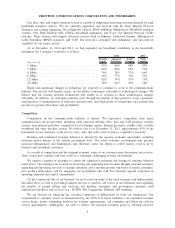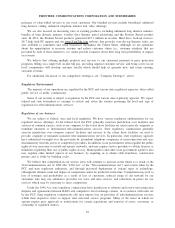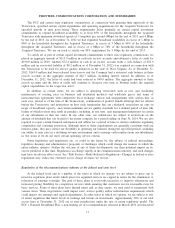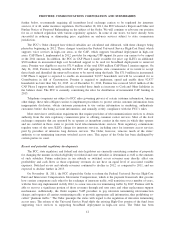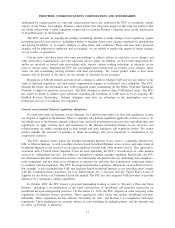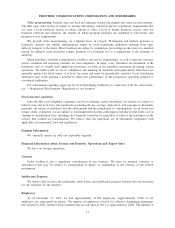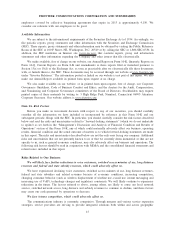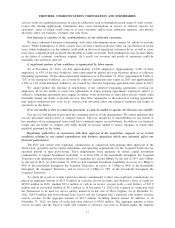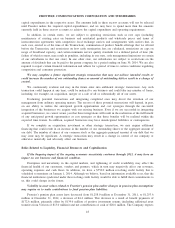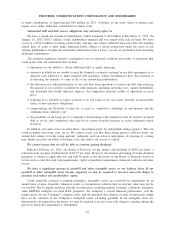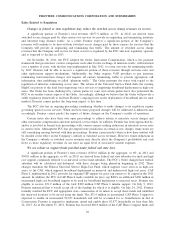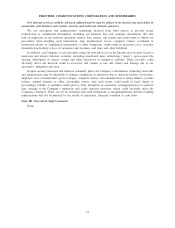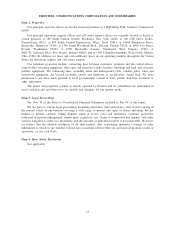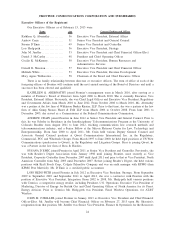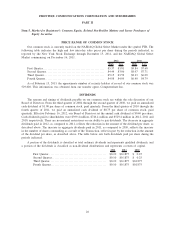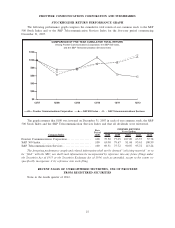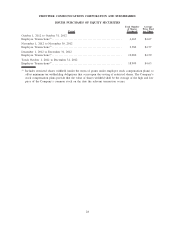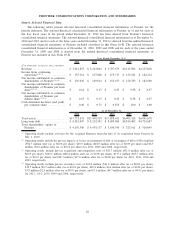Frontier Communications 2012 Annual Report Download - page 20
Download and view the complete annual report
Please find page 20 of the 2012 Frontier Communications annual report below. You can navigate through the pages in the report by either clicking on the pages listed below, or by using the keyword search tool below to find specific information within the annual report.to make contributions of approximately $60 million in 2013. Volatility in our asset values or returns may
require us to make additional contributions in future years.
Substantial debt and debt service obligations may adversely affect us.
We have a significant amount of indebtedness, which amounted to $8.9 billion at December 31, 2012. On
January 15, 2013, $502.7 million of this indebtedness matured and was retired with cash on hand. We have
access to a $750.0 million revolving credit facility and may also obtain additional long-term debt and working
capital lines of credit to meet future financing needs, subject to certain restrictions under the terms of our
existing indebtedness. Despite the substantial indebtedness that we have, we are not prohibited from incurring
additional indebtedness.
The potential significant negative consequences on our financial condition and results of operations that
could result from our substantial debt include:
•limitations on our ability to obtain additional debt or equity financing;
•instances in which we are unable to meet the financial covenants contained in our debt agreements or to
generate cash sufficient to make required debt payments, which circumstances have the potential of
accelerating the maturity of some or all of our outstanding indebtedness;
•the allocation of a substantial portion of our cash flow from operations to service our debt, thus reducing
the amount of our cash flow available for other purposes, including operating costs, capital expenditures
and dividends that would otherwise improve our competitive position, results of operations or stock
price;
•requiring us to sell debt or equity securities or to sell some of our core assets, possibly on unfavorable
terms, to meet payment obligations;
•compromising our flexibility to plan for, or react to, competitive challenges in our business and the
communications industry; and
•the possibility of our being put at a competitive disadvantage with competitors who do not have as much
debt as we do, and competitors who may be in a more favorable position to access additional capital
resources.
In addition, our senior notes are rated below “investment grade” by independent ratings agencies. This can
result in higher borrowing costs for us. We cannot assure you that these rating agencies will not lower our
current debt ratings, if in the rating agencies’ judgment, such an action is appropriate. A lowering of a rating
may further increase our future borrowing costs and reduce our access to capital.
We cannot assure that we will be able to continue paying dividends.
Effective February 16, 2012, our Board of Directors set the annual cash dividend at $0.40 per share, a
reduction from our prior dividend level of $0.75 per share. However, the amount and timing of future dividend
payments is subject to applicable law and will be made at the discretion of our Board of Directors based on
factors such as cash flow and cash requirements, capital expenditure requirements, financial condition and other
factors.
We have a significant amount of goodwill and other intangible assets on our balance sheet. If our
goodwill or other intangible assets become impaired, we may be required to record a non-cash charge to
earnings and reduce our stockholders’ equity.
Under generally accepted accounting principles, intangible assets are reviewed for impairment on an
annual basis or more frequently whenever events or circumstances indicate that its carrying value may not be
recoverable. The Company monitors relevant circumstances, including general economic conditions, enterprise
value EBITDA multiples for rural ILEC properties, the Company’s overall financial performance, and the
market prices for the Company’s common stock, and the potential that changes in such circumstances might
have on the valuation of the Company’s intangible assets, including goodwill. If our intangible assets are
determined to be impaired in the future, we may be required to record a non-cash charge to earnings during the
period in which the impairment is determined.
19
FRONTIER COMMUNICATIONS CORPORATION AND SUBSIDIARIES


